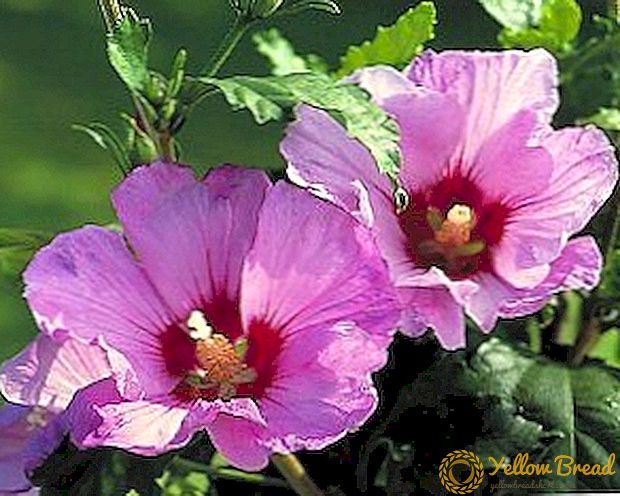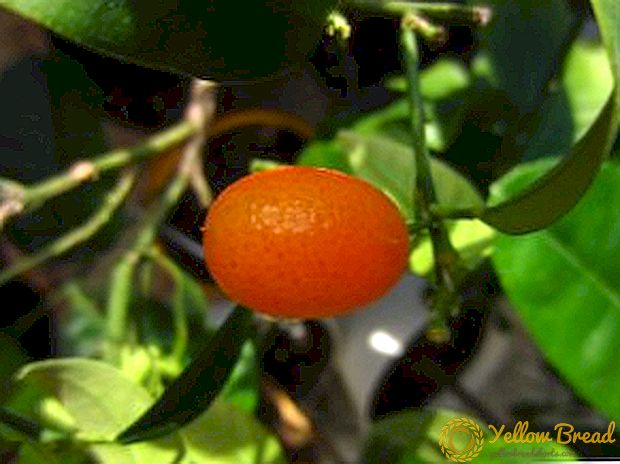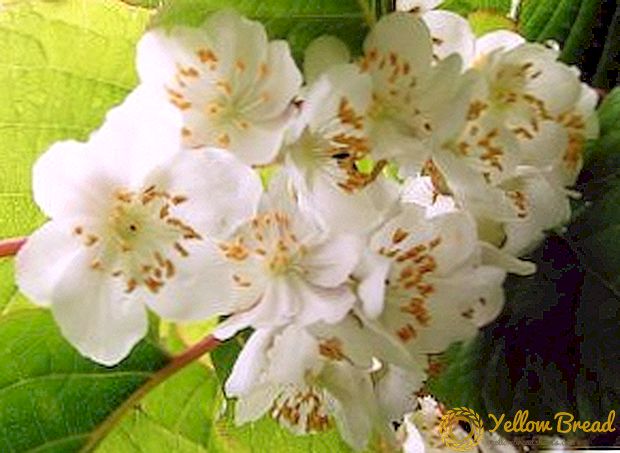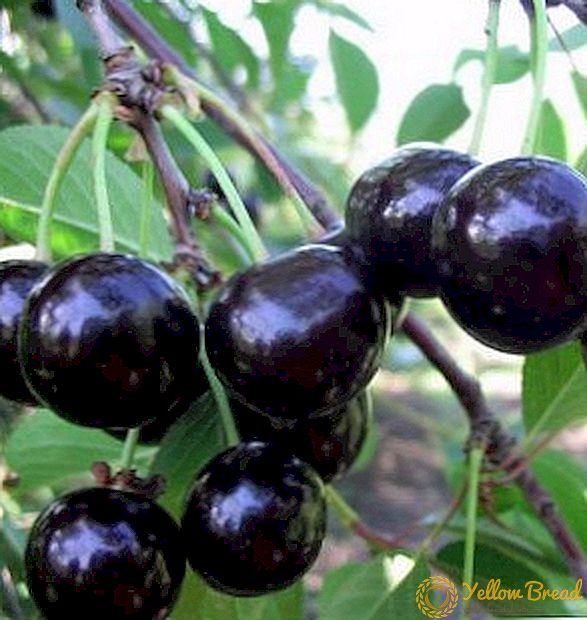 Zefirantes came to our homes from North, Central and South America. The name of the flower comes from the Greek, from the words "Zephyr" - the ancient Greek god of the western wind, and "anthos" - "flower". People also call it "rain lily" or "upstart," due to the very rapid development of the peduncle - from emergence from the ground to flowering.
Zefirantes came to our homes from North, Central and South America. The name of the flower comes from the Greek, from the words "Zephyr" - the ancient Greek god of the western wind, and "anthos" - "flower". People also call it "rain lily" or "upstart," due to the very rapid development of the peduncle - from emergence from the ground to flowering.
- Types of Zephyranthes
- Optimal conditions for growing in the house
- Lighting
- Temperature
- Peculiarities of home care
- Watering
- Feedings
- Transplant rules: soil and pot
- Propagation by daughter bulbs
- Possible difficulties: diseases and pests
Zefirantes belongs to the Amaryllis family, numbering up to 90 species. In warm regions, it is customary to grow it in the open field, and here it has taken root as a rather unpretentious and decorative home plant.
Types of Zephyranthes
In our area, the most widespread are 6 species of zephyranthes:
- Zephyranthes snow white, or white (Zephyrantes candida), is distinguished by white pointed petals on peduncles up to 20 cm tall. The bulb is round and reaches a diameter of 3 cm. Flowering begins in the middle of summer and lasts until October.

- Atamas (Zephyrantes atamasca) prefers cool rooms and blooms from March to April. Bulb up to 2 cm, egg-shaped, leaves are long, narrow, dark green color, white flowers, 3-4 cm in length.
- Zefirantes robustus, or powerful (Zephyrantes robusta), differs in light pink flowers reaching 6 cm. The bulb is 4 cm in diameter. It blooms from April to July. One of the largest representatives of the species, originally from Brazil and Argentina.
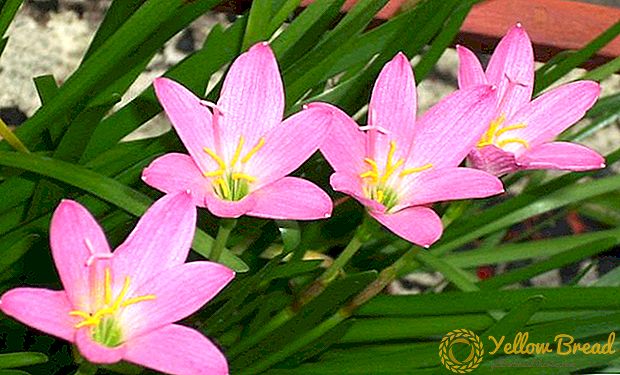
- Golden (Zephyrantes aurea) has thin, long leaves, reaching 30 cm, blooms in yellow from the beginning of winter until February. Prefers cool rooms.
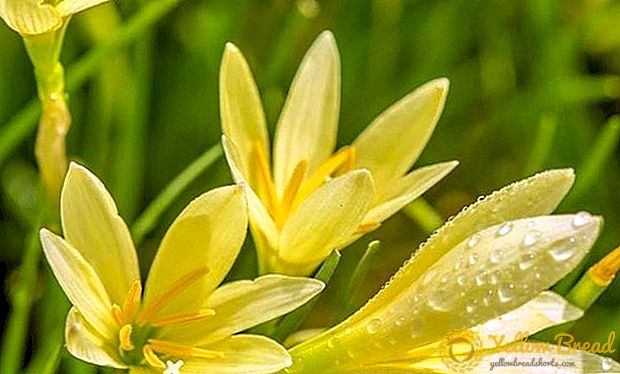
- Large-flowered (Zephyrantes grandiflora) has an ovoid onion up to 3 cm in diameter, leaves grooved to a height of 30 cm and a width of 0.5-0.7 cm. It blooms from April to July. For this variety, it is important to observe a dormant period from September to February, when it is no longer watered, the leaves are cut and they are put to winter in a cold room, such as a cellar or a refrigerator.
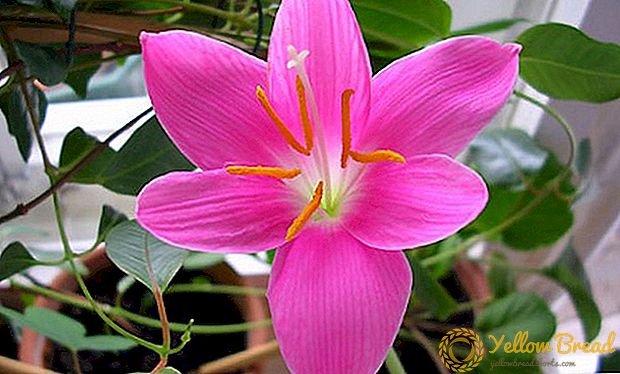
- Multicolored (Zephyrantes versicolor) is distinguished by the fact that peduncles appear before the leaves, and the flowers have a beautiful color — white on top, and inside and outside, near the peduncle, red-green.It blooms in January and loves coolness too.
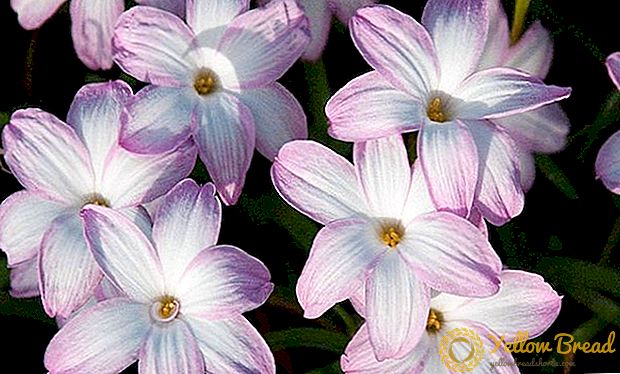

Optimal conditions for growing in the house
Despite its unpretentiousness, the plant will be healthy and abundantly blooming with the fulfillment of very simple requirements for lighting and temperature.
Lighting
The flower during the growing season and flowering will be grateful for the bright sunlight scattered light. In summer, you can easily land it on the balcony or in the open ground. And indoors, select the lighted window for it: south, west or east.  But there are species that shed their leaves for the winter and need rest, because they are put in a dark room until spring.
But there are species that shed their leaves for the winter and need rest, because they are put in a dark room until spring.
Temperature
Zefirantes is considered an undemanding home care plant, and the air temperature is the same as for humans.
The optimum summer temperature is 19-24 ° C, and in the rest period is enough 10-12 ° C, but here it is important not to overdo it and not lower the temperature below 5 ° C, otherwise the plant will die.
Peculiarities of home care
One of the main causes of wilting and lack of growth of zephyranthes may be improper watering or lack of fertilizer. Because it is important to know exactly how to care for the flower. 
Watering
The plant likes abundant watering in the summer, and during the growing season and flowering. But you do not need to fill it and allow stagnant moisture in the pot.
Water the flower when the ground in the pot has dried out a bit. In winter and in the dormant period, watering is stopped completely to avoid rotting of the bulbs, and begin in the spring, or at the end of February, when new leaves appear.
Feedings
During the growing season and flowering Zefirantes are fed with a liquid universal fertilizer every 2 weeks according to the dosages specified by the manufacturer.
Transplant rules: soil and pot
Care marshmallow is not difficult, it also applies to his transplant. This procedure is carried out annually at the end of the rest period, usually in the spring.  The pot is chosen not much larger than the previous one, it is better if it is clay and low.More decorative and lush flowering will be, if you plant not one onion in one pot, but several, leaving their tops 1/3 above the ground.
The pot is chosen not much larger than the previous one, it is better if it is clay and low.More decorative and lush flowering will be, if you plant not one onion in one pot, but several, leaving their tops 1/3 above the ground.
Soil for planting should be loose, can be combined in equal amounts of sand, leaf soil and humus. A good drainage is laid on the bottom to avoid rotting of the bulbs.
Propagation by daughter bulbs
Propagate marshmallows in room conditions - simple. Maternal bulb gives up to 15 children, which are easily separated from it. Place the office should be sprinkled with coal and transplant the bulbs in a separate pot.  If the bulb is high, then the neck can be left slightly above ground level. Flowers from little babies bloom the very next year.
If the bulb is high, then the neck can be left slightly above ground level. Flowers from little babies bloom the very next year.
Possible difficulties: diseases and pests
Let's see why in the room conditions does not bloom zephyrans, or fades and grows poorly.
The plant is quite stable against diseases, but such pests can appear:
- Spider mite Dry air in the house contributes to its development.A cobweb appears on the leaves and buds, they fade and may fall off over time. Rubbing with soapy water and further bathing the flower in the shower can help in the early stages of infection. If the process is aggravated, then Acartell, a widespread acaricide, 0.15% solution will help.
- The amaryllis scale is small, up to 3 mm, white oval insects, after the attack of which the flower fades, and the leaves turn yellow and fall. The excretions of this pest can provoke the appearance of a black fungus, which is much more dangerous than the worm itself. You need to fight it with proven insecticides, such as "Aktara", "Fitoverm", "Aktellik".
- The shield is brownish small insect plaques that spread throughout the plant, feeding on its juice. The flower is in a generally depressed state, the leaves curl and dry together with the buds. She is also struggling with the above insecticides.







